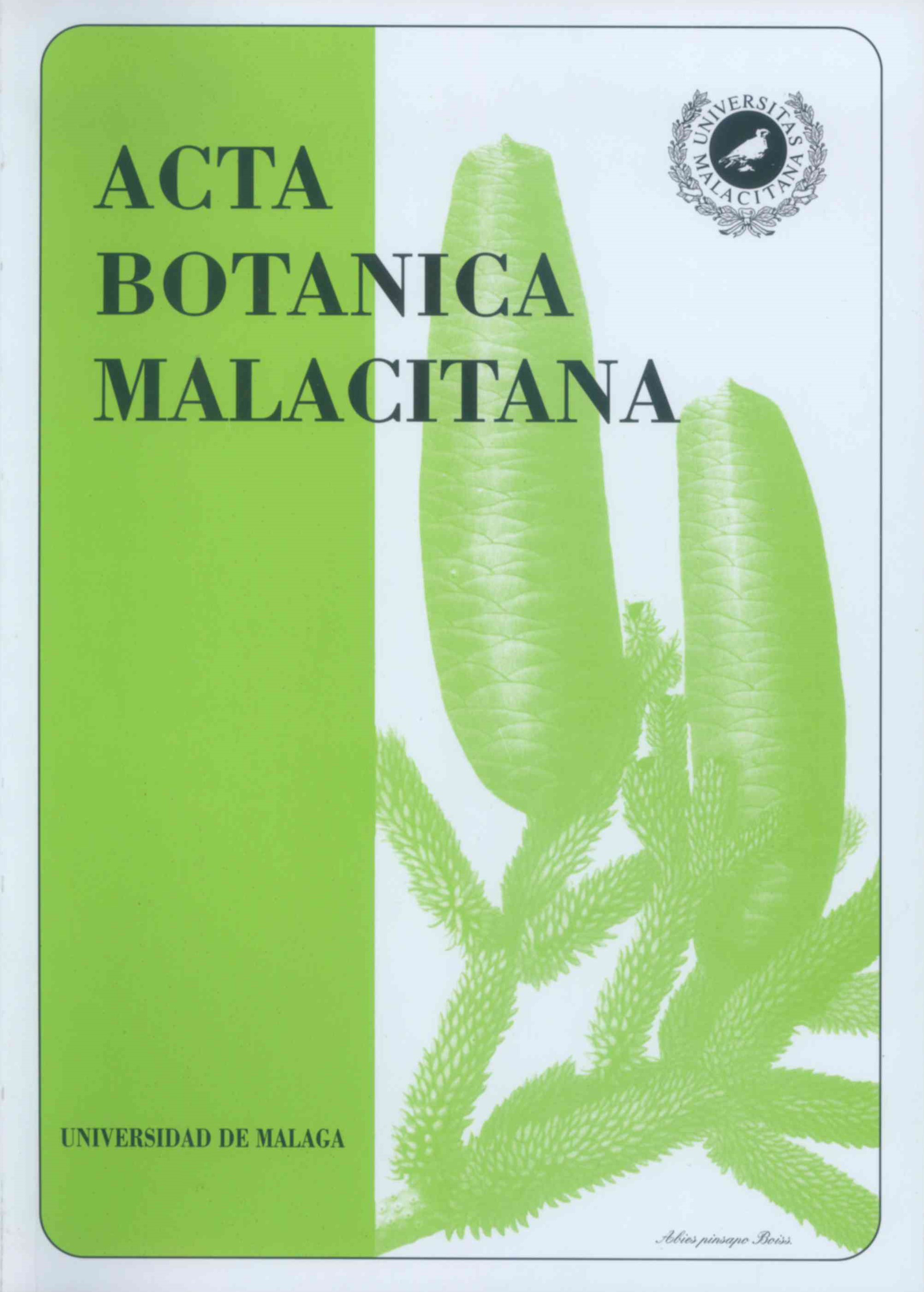Ana?lisis del contenido aeropoli?nico estival en la provincia de Ma?laga
DOI:
https://doi.org/10.24310/abm.v26i0.7402Abstract
RESUMEN. Análisis del contenido aeropolínico estival en la provincia de Málaga. En el presente trabajo se realiza un estudio del contenido polínico de la atmósfera de la provincia de Málaga durante cl periodo estival (Julio-Septiembre) tomando los registros obtenidos durante los últimos años en varias localidades de la provincia: Málaga (1992-1999), Estepona (1995-1997), Antequera (1998-1999) y Nerja (2000). En general, durante estos tres meses se recoge sólo entre el 3 y el 6% del polen anual, estando el espectro aeropolínico estival de Málaga representado básicamente por 14 tipos polínicos: Eucalyptus, Castanea, Parkinsotzia, Cannabis, Apiaceae, Ligustrum, Chenopodiaceae-Amaranthaceae, Palmae, Compositae, Artemisia, Typha, Cyperaceae, Poaceae y U rticaceae. Los tipos que alcanzan mayores concentraciones son Eucalyptus, Chenopodiaceae-Amaranthaceae y Poaceae. El resto de los taxa citados aparecen en concentraciones muy bajas. Determinados taxa presentan concentraciones más elevadas en determinadas estaciones de muestreo: Castanea y Compositae en Antequera, Palmae y Parkinsonia en Málaga, y Artemisia en Nerja. La evolución a lo largo de los tres meses muestra, en general, dos tipos de tendencia: una descendente de Julio a Agosto (presente en todos los tipos polínicos estudiados, excepto en Artemisia y Palinae, y en todas las zonas estudiadas) y otra ascendente, de Agosto a Septiembre, de pequeña intensidad, aunque muy acusada para los dos tipos anteriores y para Chenopodiaceae-Amaranthaceae y Cotnpositae. La mayoría de los tipos polínicos estudiados tienen sus máximos diarios en primavera, estación del año con mayor concentración polínica en el sur de Europa, excepto Eucalyptus, Castanea, Parkinsonia y Cannabis, que generalmente lo tienen en verano, y que alcanzaron máximos históricos relevantes: Eucalyptus en 1994 (112 granos/111 3), Castanea en 1997 (233 granos/m 3), Cannabis en 1998 (28 granos/m 3).
Palabras clave. Acrobiología, polen, verano, turismo, alergia, Málaga, sur de España.
ABSTRACT. Analysis of the summer airborne pollen contera in the province of Malaga. In this work, a study about the atmospheric pollen content during the period July-September has been carried out in the province of Malaga. The study was made taking the data obtained during the last years in several localities of the province: Malaga (1992-1999), Estepona (1995-1997), Antequera (1998-1999) and Nerja (2000). In general, just between 3 and 6% of the annual total pollen were collected during those three months, the airborne pollen spectrum being represented by 14 pollen types: Eucalyptus, Castanea, Parkinsonia, Cannabis, Apiaceae, Ligustrum,Chenopodiaceae-Amaranthaceae, Palmae, Compositae, Artemisia,Typha, Cyperaceae, Poaceae y Urticaceae. During the period studied, the pollen types that reached highest concentrations were Eucalyptus, Chenopodiaceae-Amaranthaceae and Poaceae while the rest of the cited taxa were detected at very low concentrations. Some taxa present higher concentrations at determined sampling stations: Costana(' and Compositae in Antequera, Palmae and Parkin.s. onia in Malaga, and Artemisia in Ncrja. The evolution along the summer season shows, in general, two trends. The first one, in
which the pollen concentrations are decreasing from July to August, is present in all the taxa and localities studied, except in Artemisia and Palmae. The other one, in which the pollen concentrations lightly increase from August to September, is present in the former two pollen types but also in Chenopodiaceae- Amarantliaceae and Compositae. Most of the pollen types studied reach their maximum daily peaks in spring (season in which the pollen concentrations are highest in southern Europe) except Eucalyptus, Castanea, Parkinsonia and Cannabis, that generally presented them in summer. These taxa reached notable maximum daily concentrations values: Eucalyptus in 1994 (112 grains/m 3), Castanea in 1997 (233 grains/ in3), Cannabis in 1998 (28 grains/m 3).
Key words. Aerobiology, pollen, summer, tourism, allergy, Malaga, southern Spain.
Downloads
Metrics
Downloads
Published
How to Cite
Issue
Section
License
Those authors who publish in this journal accept the following terms:
a. The authors will retain their copyrights and guarantee the journal the right of first publication of their work, which will be simultaneously subject to the Creative Commons Attribution-Non-commercial 4.0 license whose full text can be found at <http: // creative commons .org / licenses / by-nc / 4.0> that allows third parties to share the work as long as its author and its first publication are indicated, and as long as it is not for commercial purposes.
b. Authors may adopt other non-exclusive licensing agreements for the distribution of the version of the published paper (e.g., deposit it in an institutional telematic file or publish it in a monographic volume) provided that the initial publication in this journal be indicated.
c. Authors are allowed and recommended to disseminate their work through the Internet (e.g., in institutional telematic archives or on their websites) before and during the submission process, which can produce interesting exchanges and increase citations of the published work. (See The effect of open access)







1.png)
